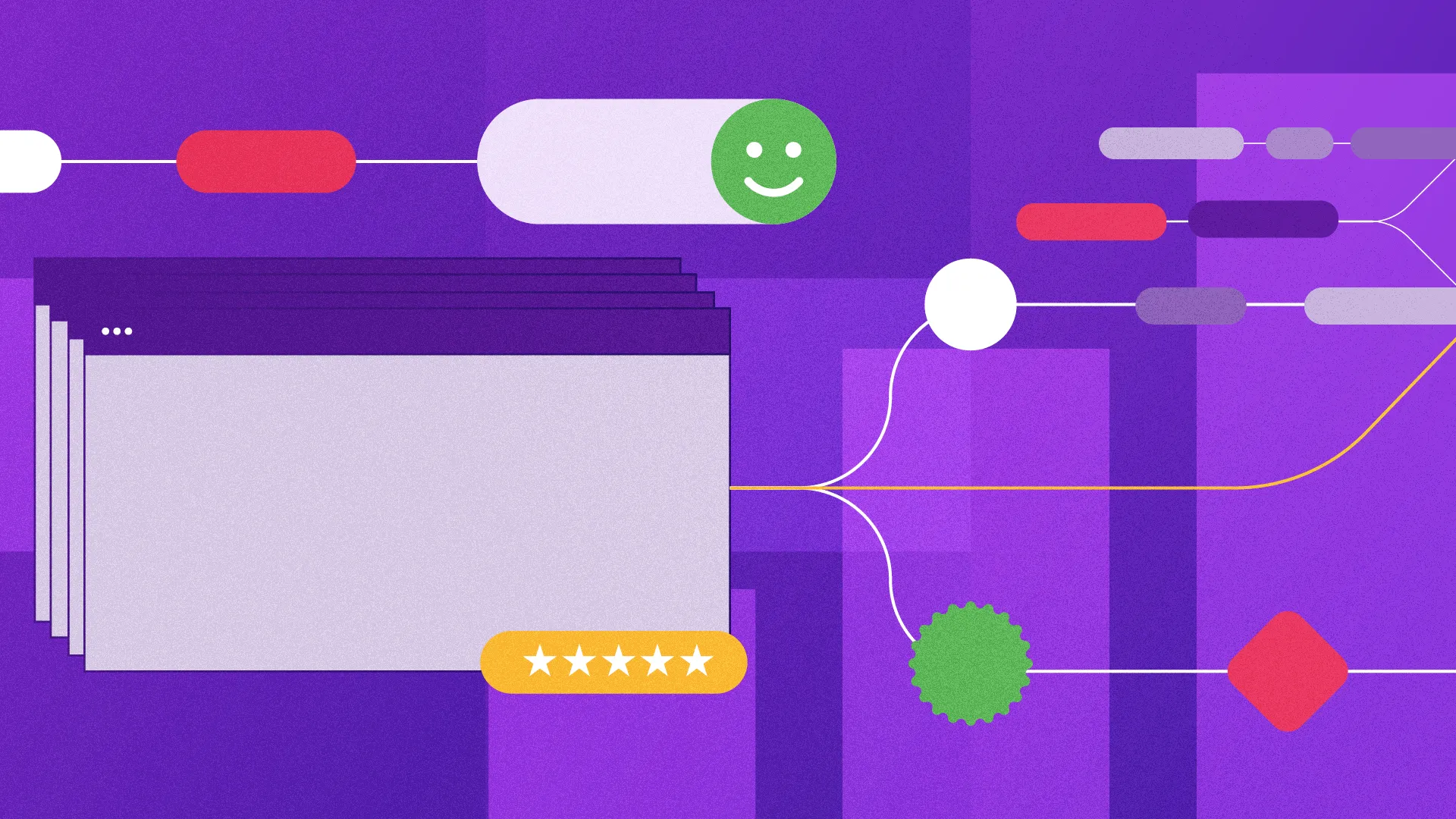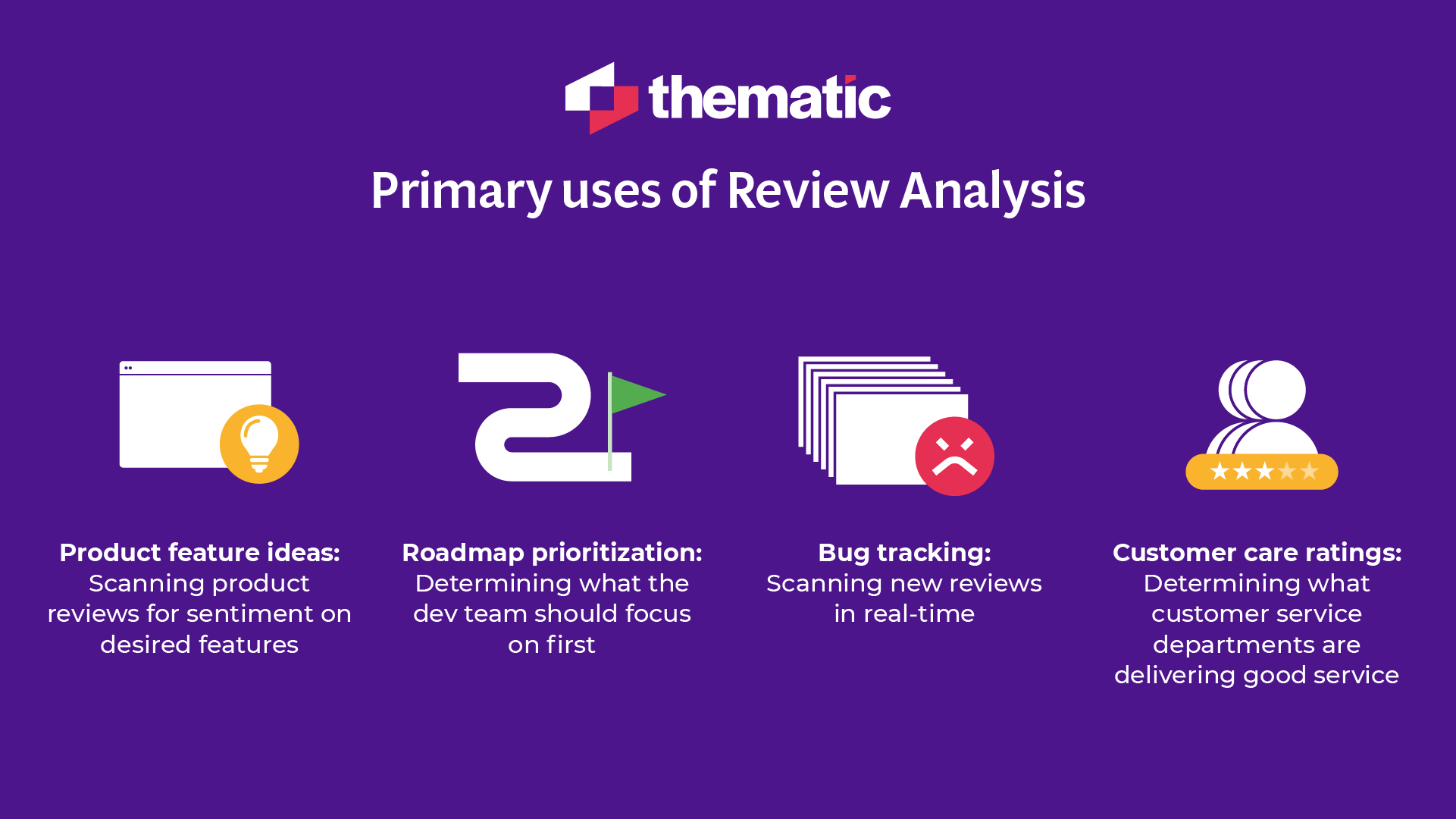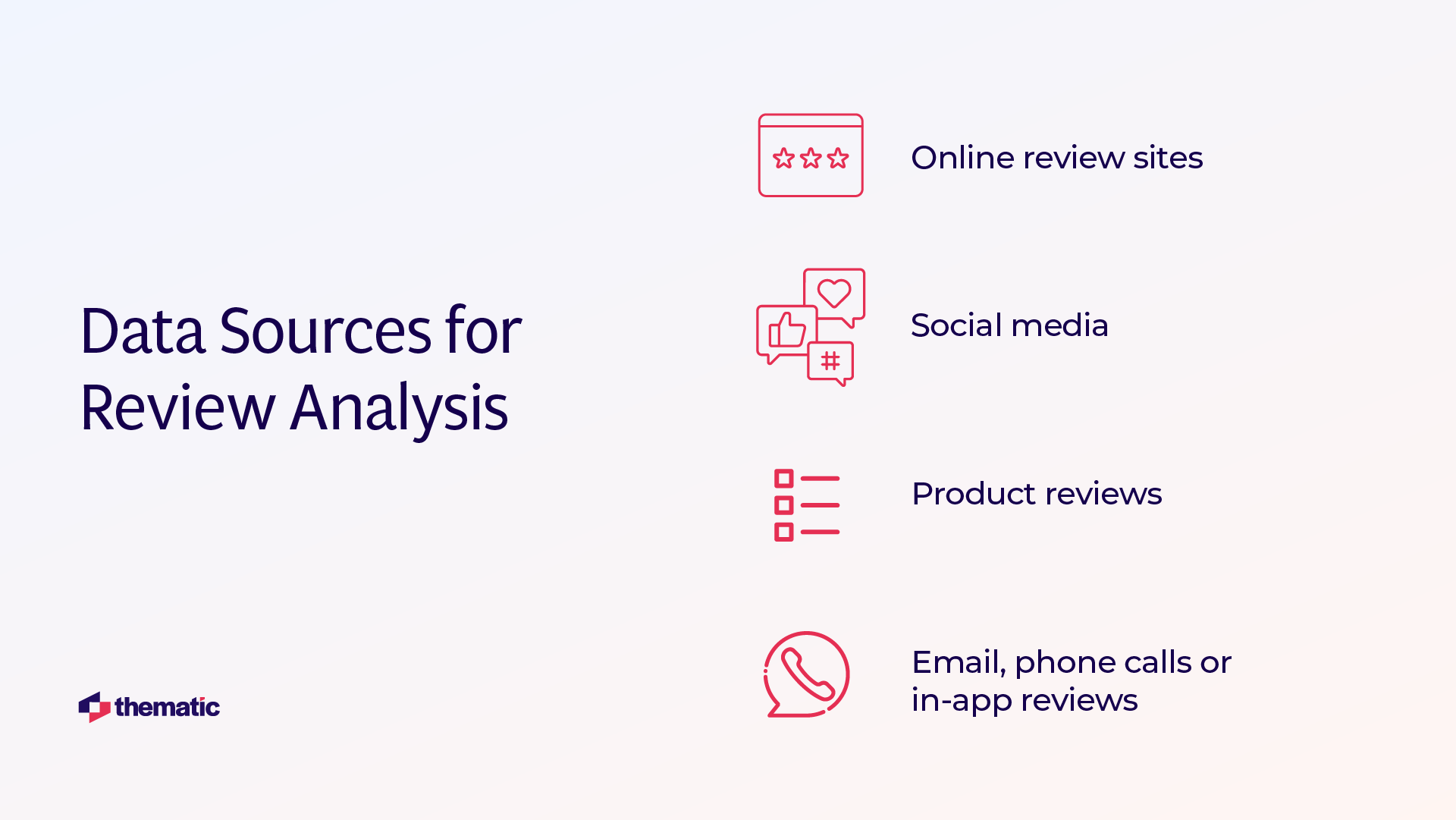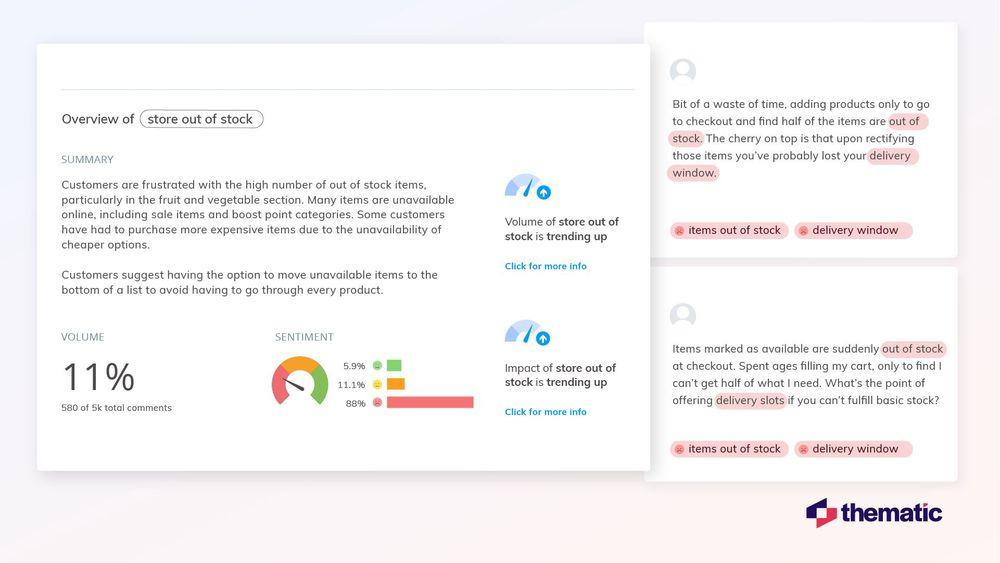
What review analysis is and how businesses use it to make better, data-driven decisions.

86% of consumers are reluctant to buy from a company with too many negative reviews. Responding to customer concerns is more important than ever before. And that’s where review analysis comes in.
Product reviews are one of the most comprehensive and useful sources of insider info available. These often have gold nuggets that can guide development, troubleshoot new initiatives, and improve customer experience. They can also tell you how you measure up against the competition by identifying market opportunities and areas for improvement.
But customer reviews are plagued with one big problem. Human experience described in qualitative terms is always going to be messy. There’s no data you can pull out with a simple command +F search. Trying to make sense of customer experiences shared in thousands of unstructured reviews can feel like tidying up the shells on a seashore.
The mountains of qualitative data locked away in reviews often means operations management teams only look at star ratings. Go a bit further, and they might read through a small sample of positive and negative comments. But to get the most out of customer reviews you need a way to rapidly analyze large quantities of unstructured data. The best way to do this is using an AI-powered analytics tool that can give you valuable insights in seconds.
In this article we’ll cover what review analysis is and how businesses use it to make better, data-driven decisions. We’ll also go over the four main steps you need to get started with review analysis, and how to choose the right AI-powered analysis tool for your specific needs.
Review analysis is the process of transforming unstructured review data into structured data that can be used to guide decision-making.
A few primary uses of review analysis insights include:

For instance, a tablet manufacturer might analyze their Amazon reviews and discover that they need to invest in better packaging. Alternatively, their review data might show customer expectations have changed and they now want a startup time of under 30 seconds.
Analysis of online travel reviews could be used to provide market analysis for service providers, or build a recommendation system for future travelers. And analysis of app store reviews could tell developers they need to work on better GPS connectivity or let them know that their map design is much appreciated (and any changes should be rolled out slowly!). Positive reviews of specific team members can also be a useful way to identify and recognize top-performing employees.
Review analysis is important because it helps you understand what customers really think of your app, site, or experience. It enables you to become a more customer centric company. A company that doesn’t analyze customer reviews might end up basing development decisions on criteria like what is easiest to tackle first or the CEO’s personal preferences.
Here’s a more detailed look at real-world examples of how businesses use review analysis:
Reviews can tell you a lot about the customer journey and how to make it better. For instance, Atom Bank used Thematic’s AI-powered tool to analyze data from seven feedback channels and three product lines. Their aim was to find out which parts of the customer experience they could improve. Using Thematic they were able to identify the main issues their customers were facing and take action to address these. The result was a 40% reduction in call center volume and 110% growth in the Atom bank customer base.
Review analysis is also useful for understanding what your customers do and don’t like about your products. It can reveal hidden issues that you didn’t know about. This data is invaluable for targeted product validation and improvements. For instance, the Melodics team used Thematic to analyze customer feedback from many different channels. One of the insights that stood out was the lag in the app. Melodics was then able to create specific projects to address this issue.
Tracking what customers are saying about you in online reviews can give valuable insights into your brand reputation. For example, an organization might monitor reviews over time to see how customer opinion about them is changing. If there was a significant drop in customer sentiment, they could dig deeper into the data to uncover and address the specific issues causing this negative feeling. Taking action on these insights is the path back to building a positive brand reputation
If you’re using an AI-powered analytics tool like Thematic you can often set up alerts to notify you if urgent issues come up in your review data. For example, you might set an alert for a hot topic like “data breach” or “privacy”. If there is a spike in the volume of reviews mentioning this topic you’ll automatically be notified. And your team can swing into action and fix it right away.
Reviews can also be great for finding out more about your customers so you can personalize your marketing campaigns. Digging deep into your review data can uncover new pain points or features current customers love. This is all great material for creating content that really resonates with your target market.
Finally, remember that review analysis doesn’t have to be limited to your own reviews. Analyzing your competitors’ gives you a better picture of their strengths and weaknesses. And it also enables you to identify potential opportunities and gaps in the market. For example, you might notice that many of their customers complain about a particular feature that’s missing from their products. Addressing this gap could help strengthen your market position.

Before getting started with review analysis you’ll need to think about which review data you want to use. Bear in mind that there can be big differences between different channels and sites. For example, Facebook attracts more informal reviews whereas G2 reviewers typically write more detailed technical comments. Reviewers may also be more open when writing reviews on third-party sites compared to your company’s app or website.
Certain demographics may also prefer to use specific channels. For example, social media reviewers tend to be younger and more tech-savvy, while Yelp is much more popular in North America than in Europe. It’s recommended to pull reviews from several channels to get a diverse range of viewpoints.
Here’s some examples of where you might source your review data from:

Review analysis used to be a slow, time-consuming manual process. Now AI-powered tools make it easy to analyze thousands of reviews in seconds. In this section we’ll cover the 4 steps you need to follow to successfully analyze your reviews so you get actionable insights that actually make an impact.
Before you begin it’s a good idea to plan which tools you’ll use to analyze your reviews. Advanced AI analytics tools like Thematic are able to analyze huge quantities of reviews and condense that data into accurate insights.
We recommend you start by thinking about what you want to achieve from analyzing your reivews and how you will share and use your results. You can then select the solution that best matches your goals, budget and technical requirements. For example, larger organizations with significant quantities of complex unstructured data will need a more advanced AI solution. You’ll find more tips on choosing the right tool in the next section below.
The next step is to select the data you want to analyze and to collate it all in one place. The easiest way to do that is to use an AI analytics tool like Thematic. Most advanced analytics tools have ready-made integrations with all the big online review sites and social media platforms. If you are planning to use reviews from your website or app, check how easy it is to upload them to the analytics tool you’re using.
Part of this step also includes preparing your data for AI analysis. This is usually done automatically these days by analysis tools. They preprocess and clean the data by removing things like links, slang, and any other unnecessary elements.
You’re now ready to analyze your data. Most advanced analytics solutions like Thematic use large language models (LLMs) with traditional non-generative AI. Models are auto-evaluated and optimized to make sure the right model is being used for each task. The goal of these thematic analysis tools is to automate “theme” or topic discovery in text. They scan through all your review data and identify all the recurring topics even when different wording is used.
Thematic works by combining sentiment analysis with thematic analysis to help you better understand what your customers feel about a particular topic. In the example below you can see the results for the topic or theme “store out of stock”. This topic has appeared in 11% of the reviews analyzed. This could indicate it’s an important issue to focus on.
The insights below show you that 88% of the mentions of this theme are negative. So clearly these customers are not happy about it! You can also see a summary of the theme which gives more details about how your customers feel. They’re frustrated with out of stock items and some customers have had to buy more expensive items as the cheaper ones were out of stock. This gives you a clear picture of what your teams need to work on to make your customers happier.

Step 4: Share Your Insights and Take Action
Insights are only valuable if you use them. Most advanced AI analytics tools make it easy to share insights and visualizations across your organization. We recommend ensuring that feedback is accessible to all departments, from product development to customer service. You can better empower each team to act on relevant insights and get buy-in from stakeholders by sharing the data behind your recommendations.
And finally, don’t forget to follow up with customers after acting on their reviews. For example, you could reach out to customers who had urgent or high impact issues to let them know what you’ve done to fix it. This can help improve customer retention and boost brand loyalty by showing that you really listen to what they say.
Our final recommendation is to use your insights to keep improving your products, services, and customer interactions. Aim to create a feedback loop that enhances the customer experience over time. As you take action on your analytics findings you should see a positive impact in your review data and more and more happy customers!
There are many different AI-powered analytics tools on the market, so choosing the best one for your business can be tricky. When you’re considering which tool to select, think about what you want to achieve and what type of data you have. Here’s a few recommendations to help you choose the review analysis tool that’s right for you:
Here are some popular AI analytics tools for review analysis:

So next time you look at an unorganized database of review data, remember that this isn't a collection of disparate, chaotic data points. With appropriate analytics and an advanced AI analysis tool like Thematic, this dataset can become a goldmine of knowledge.
In this article we’ve covered the basics of review analysis and how you can apply it to your own data to get high-quality, actionable insights. But the work doesn’t stop there. Take prompt action on your customers’ feedback and let them know that you’ve acted on their input.
And once that’s done, keep monitoring new reviews to pick up on any emerging issues that might need attention. That’s how you create a feedback loop that enhances the customer experience over time, and show your customers you’re really listening!
Ready to unleash advanced AI-powered analysis on your reviews? You can now try out a free guided demo of Thematic using your data.
Join the newsletter to receive the latest updates in your inbox.